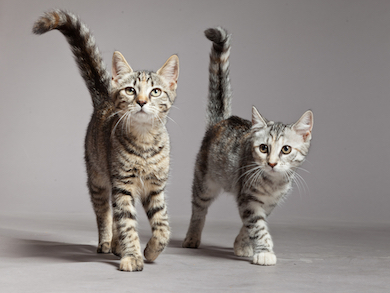Pet Insurance Review > Pet Wellness Guides > % Common Cat Behavioral Problems - Pet Insurance Review
Common Cat Behavioral Problems
Posted: 01/20/2023 | BY: Content Writer | Categories: Behavior , Cat , Top Tips
We love our feline friends more than anything but there are common cat behavioral problems that will have any cat owner scouring the internet for ways to correct them. We’ve combined the 5 most common cat behavioral problems below and how to fix them.

Litter box issues: This is the number one problem people report with their cats. It can be extremely frustrating when your cat goes to the bathroom everywhere but where they’re supposed to. However, there’s usually a reason your cat is avoiding their litter box and fortunately there are multiple things you can do to correct this problem.
-
Talk to your vet. Urinary tract infections and bladder stones are just two reasons your cat may be avoiding the litter box. Bring your cat to the veterinarian to rule out these health issues.
-
Have the correct amount of litter boxes. The general rule is to have at least one litter box per cat. If your cat has to wait its turn to relieve itself, they may decide to make somewhere else their bathroom.
-
Try different kinds of litter boxes and litter. Some cats prefer covered boxes and some don’t. Some cats are very specific about the type of litter under their paws so it’s advisable to try a few until your finicky feline seems happy!
-
Always keep the litter box clean. Even clumped litter should be changed regularly. A general rule is to clean the litter box at least once a day, twice if there’s more than one cat.

Scratching: Sometimes it seems like our cats are clawing at our furniture just to spite us but the reality is, they’re just trying to work off energy, play, mark their territory, and trim their claws. The good news is, scratching is very easy to prevent.
-
Buy one or more scratching posts for your cat, then dab a bit of catnip on the posts to entice them into using the post, instead of your furniture.
-
Trim your cats’ claws. It may seem difficult but trimming their nails is actually pretty seamless. Get a quick tutorial from your vet and you’ll be able to clip your cats’ claws in about ten minutes total regularly.
-
If you can’t trim your cats’ claws for whatever reason, invest in nail caps for your cat. Small sleeves that fit over a cat’s claws and prevent them from damaging anything when they scratch. You can get these from your vet or find them at any pet store, as well as online.
Cat aggression: Your cat could become aggressive for a multitude of reasons. Such as illness, overcrowding, lack of socialization, and even just because they want to play. There are many ways to tackle cat aggression and get your cat back to their cuddly purring self.
-
Discuss your cat’s aggression with your vet. Rule out any illness that’s bound to make your cat in a sour mood and work to get your cats’ health in shape.
-
Ensure that your cat is fixed as this could lead to aggression. Always spay or neuter your cats!
-
Ensure that your cat has a scratching post, toys to play with, and that you’re also paying attention to them. Lack of attention and play can quickly lead to aggression.
-
If your cat does not stop its aggression, a general rule is to never yell at or swat at your cat. Alternatively, spray your cat with water to train them to stop the behavior. This is especially effective if they’re fighting another cat.
Too much nighttime activity: Cats are nocturnal by nature and their domestication is the only reason they’re a little less on the move in the evenings. If your cat isn’t allowing you to sleep through the night, just know that this is extremely common. There are many ways to train your cat to sleep at night so that you can get some rest, too!
-
If your cat is only rowdy at night, you can help tire and relax them by playing with them before it’s time to go to sleep.
-
Make sure that your cat is preoccupied (by playing with you or with toys or with another pet) during the day so that it’s naturally easier for them to want to sleep when you do at night.
-
Because cats tend to sleep after a big meal, feed your cat their main meal at night.
Play-induced biting and scratching: Cats and kittens love playing. Your cat’s physical coordination and social skills are honed by each swat and pounce. But sometimes our feline friends can get a little too rowdy with their humans and scratch or bite us. Fortunately, there are many ways to minimize rough cat play and save you a trip to your doctor.
-
Provide your cat with lots of enrichment activities. Scratching posts, toys, perches, etc. And even another cat or other pet to play with.
-
Play with your cat for at least 10 minutes twice a day. Use toys, catnip, etc.
-
Don’t encourage your cat to play with your hands or feet. Kittens who grow up playing with and nibbling on fingertips often grow up to be cats that bite and scratch hard and might end up hurting their humans.
-
Don’t punish your cat when it bites and scratches. It’s easy for a kitten or cat to interpret a slap as rough play, or to become afraid of you. Instead, walk away when they’re doing this!
Pet insurance is also a great way to keep your cat healthy, happy, and safe. Get a free pet insurance quote today through Pet Insurance Review, and ensure your pet is covered no matter what!
Find & Compare the Top Pet Insurance Companies
Get Quotes for Your CatReferences:
- ASPCA Pro. (2021). American Society for the Prevention of Cruelty to Animals. Common Cat Behavior Issues. Retrieved from https://www.aspca.org/pet-care/cat-care/common-cat-behavior-issues
The information contained on this blog is intended for informational and educational purposes only and should not be construed as medical advice. It is not a substitute for professional veterinary care. Always consult with your veterinarian before making any changes to your pet's health care or treatment plan.
The authors of this blog are not veterinarians and do not claim to be experts in pet health. The information provided here is based on our own experiences and research, as well as information from reputable sources. However, we cannot guarantee the accuracy or completeness of this information.
We encourage you to do your own research and consult with your veterinarian before making any decisions about your pet's health.